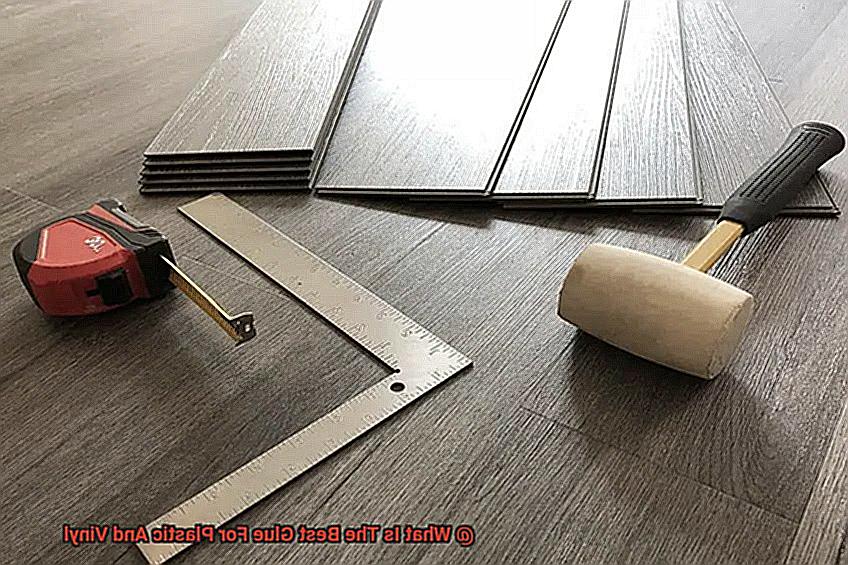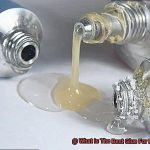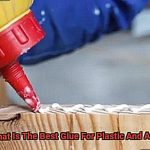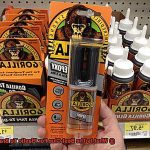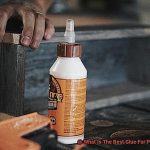Got a broken plastic item or need to secure vinyl materials?
Finding the perfect glue for plastic and vinyl can be a bit of a challenge with all the options out there.
But fear not, because I’ve got you covered. In this blog post, we’re going to dive headfirst into the world of plastic and vinyl glues and uncover the top contenders that will give you a bond so strong it could withstand a hurricane.
Get ready for some serious bonding action.
Types of Glue Suitable for Bonding Plastic and Vinyl
Contents
- 1 Types of Glue Suitable for Bonding Plastic and Vinyl
- 2 Considerations When Choosing the Right Glue for Plastic and Vinyl Bonding
- 3 Special Adhesives for Low Surface Energy Plastics
- 4 Preparing the Surfaces Before Bonding Plastic and Vinyl
- 5 How to Use Cyanoacrylate Adhesive (Super Glue) to Bond Plastics and Vinyls
- 6 How to Use Epoxy Adhesive to Bond Plastics and Vinyls
- 7 How to Use Polyurethane, Contact Cement, or Hot Glue to Bond Plastics and Vinyls
- 8 Benefits of Using the Right Type of Glue for Bonding Plastics and Vinyls
- 9 Conclusion
When bonding plastic and vinyl, selecting the right glue is crucial for a strong and long-lasting bond. With numerous options available, it can be overwhelming to determine the best choice for your project. This guide will explore different types of glue suitable for bonding plastic and vinyl, providing the information needed to make an informed decision.
Super Glue – Quick and Strong:
Super glue, or cyanoacrylate adhesive, is a popular option for bonding plastic and vinyl due to its rapid and robust bonding ability. A few drops create a tight, durable bond, making it ideal for small projects or repairs. However, it’s important to note that super glue may not be compatible with all types of plastics and vinyls, so always check the label.
Epoxy Adhesive – Durability at its Best:
For a strong and durable bond, epoxy adhesive is the go-to option. It consists of two parts – resin and hardener – that need to be mixed before application. Once mixed, the epoxy forms a powerful bond that withstands heat, chemicals, and moisture. It’s perfect for larger projects or items subjected to heavy use.
Cyanoacrylate Adhesive (Super Glue)
In the world of adhesives, one product stands out as a true superhero: cyanoacrylate adhesive, more commonly known as super glue. Whether you’re repairing a broken toy or tackling a DIY project, super glue is the go-to solution for bonding plastic and vinyl surfaces. Join us on this adhesive adventure as we explore the properties, uses, and potential hazards of this mighty adhesive.
Unleashing the Science:
Cyanoacrylate adhesive works its magic through a chemical reaction with moisture. When it encounters humidity in the air or on the surface of materials being bonded, it forms an instant and durable bond. This fast-acting glue sets in seconds, saving you time and allowing you to move forward with your project quickly.
Versatility at Its Core:
Super glue’s superhero status comes from its ability to bond various plastic and vinyl materials. It’s perfect for PVC, acrylics, ABS, polycarbonate, and more. From fixing broken toys to repairing household items to bonding automotive parts, this adhesive is a versatile companion for all your DIY needs.
Preparation for Success:
To ensure maximum bonding strength, proper preparation is essential. Clean and dry the surfaces before applying super glue. Use a mild detergent to remove dirt and grease, ensuring a clean surface for optimal adhesion. Thoroughly drying the surfaces eliminates any moisture that could compromise the bond.
Applying with Precision:
Applying super glue is a breeze. Squeeze a small amount onto one of the surfaces to be bonded, then press the two surfaces together firmly. Hold them in place for a few seconds as the glue sets almost instantly. However, allowing it to fully cure for 24 hours will ensure maximum strength and durability.
Compatibility Matters:
Not all plastics and vinyl are created equal. Some have low surface energy or chemical resistance, making it challenging for super glue to adhere properly. Before proceeding with bonding, it’s crucial to test the adhesive on a small, inconspicuous area to check compatibility and ensure a successful bond.
Epoxy Adhesive
Epoxy adhesive, the superhero of adhesives, is here to save the day and bond your plastic and vinyl materials like never before. This versatile adhesive is a two-part formula consisting of a resin and a hardener, creating a chemical bond that is resistant to heat, chemicals, and moisture.
When it comes to versatility, epoxy adhesive is unmatched. It can be used on a wide range of plastics, including PVC, polycarbonate, acrylics, and more. With its ability to bond vinyl materials like flooring or upholstery, epoxy adhesive has got your back no matter what type of plastic or vinyl you’re working with.
But its versatility isn’t the only thing that makes epoxy adhesive stand out. It also offers a longer working time compared to other adhesives. This means you have more time to position and adjust your materials before the adhesive sets. Gone are the days of rushing or worrying about getting it right the first time. With epoxy adhesive, you have the freedom to perfect your project.
And let’s not forget about its incredible strength. Epoxy adhesive creates a bond that can withstand heavy loads and stress. Whether you’re repairing a plastic item or creating a permanent bond between plastic or vinyl surfaces, epoxy adhesive will keep everything together, no matter what.
Of course, every superhero has their weaknesses. For epoxy adhesive, one of them is its longer curing time. Unlike other types of adhesives that dry quickly, epoxy adhesive takes its time to fully cure and reach maximum strength. But as they say, good things come to those who wait. And trust me, this extra time is worth it for the strong and long-lasting bond you’ll get.
Polyurethane Adhesive
Look no further. Join us as we delve into the extraordinary realm of polyurethane adhesive and uncover the incredible advantages it offers for bonding plastic and vinyl materials. Get ready to witness the remarkable properties that transform this adhesive into a true superhero in the glue universe.
Versatility: The Bonding Superpower
Polyurethane adhesive possesses an awe-inspiring ability to bond an extensive range of plastics and vinyls. From rigid PVC and ABS to supple vinyl upholstery and flooring, this adhesive fearlessly takes on any challenge. Its versatility has made it the go-to choice for industries such as automotive, construction, and furniture manufacturing.
Strength That Defies Time
When it comes to durability, polyurethane adhesive stands head and shoulders above the rest. It forms an unyielding bond that withstands impact and vibration, making it ideal for applications exposed to movement or external forces. Imagine securing plastic parts in a car that endure ceaseless motion and vibrations – polyurethane adhesive rises to the occasion.
Resistance to Environmental Forces
Polyurethane adhesive proves its mettle against moisture and chemicals, emerging triumphant from any battle. It maintains its bond strength even in the face of wet or humid environments, making it suitable for outdoor applications or areas exposed to liquids. Furthermore, its resistance to various chemicals, oils, and solvents ensures a bond that endures in diverse industrial settings.
Two Parts, One Invincible Bond
Polyurethane adhesive typically comes in two parts – a resin and a hardener. When these components unite, a chemical reaction is unleashed that causes the adhesive to cure and harden. The working time may vary depending on the product, but it allows ample time for precise application and alignment of bonded surfaces.
Contact Cement
Look no further. In this blog post, we will delve deep into the world of contact cement – the superhero adhesive that will revolutionize your bonding projects. From its incredible strength and versatility to its resistance against moisture and heat, contact cement is here to save the day.

Advantages of Contact Cement:
- Instant Bond: With contact cement, there’s no more waiting around for glue to dry. As soon as the adhesive comes into contact with the surfaces, it creates a strong and durable bond in an instant. Talk about efficiency. Whether you’re assembling furniture, repairing a broken PVC pipe, or working on an acrylic craft project, contact cement ensures a steadfast bond without any delay.
- Versatility: Contact cement is a master of bonding different types of plastics and vinyl. It can effectively bond materials such as PVC, acrylic, polycarbonate, and more. Whether you’re crafting delicate acrylic jewelry or assembling industrial materials, contact cement has got you covered. Its versatility knows no bounds.
- Resistance to Moisture and Heat: Don’t let environmental factors dampen your adhesive’s performance. Contact cement is specially formulated to withstand moisture and high temperatures. So go ahead, use it to repair your vinyl upholstery in cars or even your outdoor furniture that’s exposed to rain or UV rays. Contact cement’s resistance to these elements ensures a long-lasting bond that stands up against the test of time.

Proper Application Technique:
- Even and Thin Layer: Apply contact cement evenly and thinly on both surfaces using a brush or roller. This ensures a strong bond and prevents excess glue from interfering with the final result. A smooth and precise application guarantees optimal adhesion.
- Drying Time: Allow the adhesive to dry for a few minutes before joining the surfaces together. This step is crucial for achieving optimal adhesion. Patience is key in ensuring a bond that withstands any challenge.
- Align and Apply Pressure: Carefully align the surfaces before bringing them into contact. Apply firm pressure to ensure proper adhesion and a steadfast bond. A perfectly aligned and well-pressed bond guarantees strength and longevity.

Hot Glue
Hot glue, the crafting superhero, is the ultimate adhesive when it comes to bonding plastic and vinyl materials. This thermoplastic adhesive, applied in its molten state, solidifies as it cools down, creating a strong and secure hold. Let’s delve into the world of hot glue and uncover its advantages, considerations, and safety precautions.
Firstly, let’s talk about the superpower of hot glue: its ability to create a bond that is difficult to break. When melted, hot glue seeps into the pores of plastic and vinyl surfaces, ensuring a secure attachment that other glues struggle to achieve. With hot glue, you won’t have to wait for hours for your project to dry – it sets quickly, allowing you to continue working without interruption.
Versatility is another one of hot glue’s strengths. It can be used on various plastic and vinyl surfaces, regardless of their textures or finishes. Whether you’re working with smooth plastic or textured vinyl, hot glue is up for the challenge. What’s more, it is flexible enough to bond both rigid and flexible materials, making it the go-to choice for an array of craft projects.
But wait, there’s more. Hot glue is also highly durable. It can withstand moderate stress and strain without losing its adhesive properties, ensuring that your creations stay intact for longer periods of time. However, it’s important to note that extreme temperatures or constant exposure to moisture might weaken the bond. In these cases, specialized adhesives designed for specific conditions should be considered.
Before you embark on your crafting adventures with hot glue, safety should be your top priority. Hot glue guns can reach high temperatures, so handle them with care to avoid burns or injuries. Working in a well-ventilated area is crucial to steer clear of any fumes emitted during the melting process. Remember, safety goggles may not make you look like a superhero, but they will protect your eyes from any flying glue mishaps.
Considerations When Choosing the Right Glue for Plastic and Vinyl Bonding
Well, you’ve come to the right place because I have all the tips and tricks you need to choose the right adhesive.
Let’s start with the type of plastic or vinyl you’re working with. There are various types of plastics, such as polyethylene, polypropylene, PVC, and ABS, each with its own unique chemical composition. It’s crucial to find a glue that is compatible with your specific material. Check the manufacturer’s recommendations or seek advice from an expert to ensure compatibility.
Consider the application or use of your bonded materials. Will they be exposed to extreme temperatures, moisture, or chemicals? If so, you’ll need a glue that can withstand these conditions. Look for adhesives with UV resistance and weatherproof qualities for outdoor projects.
Don’t forget about surface preparation. Clean and degrease the surfaces thoroughly before applying any glue. Dirt, dust, and grease can hinder the adhesive’s effectiveness. Some glues may even require additional preparation like roughening or applying a primer. Follow the manufacturer’s guidelines for best results.

Think about the strength requirements of your project. Different adhesives have varying levels of strength, so consider the load-bearing capacity and stress levels your bonded materials will experience. Don’t skimp on strength if you’re working on a heavy-duty project.
Drying and curing time are important factors to consider if you’re on a tight schedule. Some glues dry quickly, while others take longer to cure. Instant adhesives provide rapid bonding but may not be as strong as those with longer curing times. Choose accordingly.
Last but not least, consider ease of use and application method. Do you prefer applicator bottles or tubes? Maybe you don’t mind mixing or using special tools. Choose a glue that fits your comfort level and project complexity.
Special Adhesives for Low Surface Energy Plastics
I’m about to let you in on a little secret. Low surface energy plastics like polypropylene (PP) and polyethylene (PE) can be quite the challenge to bond. But fear not, my friend, because there are special adhesives designed specifically for these stubborn materials.
One fantastic option is cyanoacrylate adhesive. These adhesives are known for their lightning-fast curing time and unbeatable bonding strength. How do they work their magic, you ask? It’s all thanks to a chemical reaction that forms strong bonds with the plastic surface. And the best part? They’re incredibly easy to use, making them a top choice for DIY enthusiasts and professionals alike.
But wait, there’s more. Modified acrylic adhesive is another star player in the world of low surface energy plastics. These adhesives are specially formulated with reactive components that work wonders on these challenging materials. They strike the perfect balance between bonding strength and flexibility, making them a go-to for a wide range of applications.
And get this: some manufacturers even offer specialized adhesives tailored to specific types of low surface energy plastics. These crafty concoctions have formulations designed to optimize bond strength for each individual plastic material.
Before you dive headfirst into your adhesive adventure, heed this advice: proper surface preparation is key. Give that plastic surface a thorough cleaning to eliminate any dirt or grease that might interfere with your adhesive’s performance. And don’t forget, some adhesives may require a little extra help in the form of a primer or activator for an extra-strong bond.
Now, here’s the deal. While special adhesives can work wonders on low surface energy plastics, they may not be suitable for every situation. Consider factors like your intended use, environmental conditions, and load-bearing requirements when selecting the perfect adhesive for your project.
Preparing the Surfaces Before Bonding Plastic and Vinyl
Grab your cleaning supplies and let’s dive into the world of surface preparation.
First things first, cleanliness is key. Dirt, grease, and oil are major obstacles to achieving a successful bond. Grab a mild detergent or solvent suitable for the specific type of plastic or vinyl you’re working with and give those surfaces a thorough scrub. Avoid harsh chemicals or abrasives that could do more harm than good.
Once your surfaces are squeaky clean, it’s time to roughen them up a bit. Lightly sand the surfaces with fine-grit sandpaper to create a larger bonding area. This gives the adhesive something to grip onto and increases the strength of the bond. Take it easy and avoid creating deep scratches that could ruin your hard work.
Now that your surfaces are sparkling clean and slightly roughened, it’s time to ensure they’re bone dry. Moisture is the enemy of adhesion, so allow the surfaces to air dry. If you’re in a hurry, use a clean cloth or paper towel to speed up the drying process. Remember, patience is key when it comes to achieving a strong bond.
But wait, there’s more. Some plastics and vinyl may require additional help in the form of a primer or adhesion promoter. These magical substances significantly enhance bond strength, especially on tricky materials like polyethylene and polypropylene plastics. Follow the manufacturer’s instructions for applying the primer before reaching for your adhesive.
Don’t forget to consider temperature and humidity conditions. Adhesives have specific requirements for optimal bonding, so work within the recommended range. Nobody wants their bond to fail due to a temperature mishap, right?
Lastly, always read and follow the instructions provided by the adhesive manufacturer. Different adhesives may have specific requirements, so it’s important to understand them before diving into your bonding project. A little knowledge goes a long way.
How to Use Cyanoacrylate Adhesive (Super Glue) to Bond Plastics and Vinyls

Look no further. Cyanoacrylate adhesive, or super glue, is the answer. With its strong and fast-acting properties, super glue is a popular choice for DIY enthusiasts and professionals alike. In this guide, we will take you through the process of using super glue to achieve a secure and long-lasting bond between plastics and vinyls.
Step 1: Prepare the Surfaces
Before applying super glue, ensure that the surfaces you plan to bond are clean and free from dirt, grease, or moisture. Wipe them with a clean cloth or use a mild detergent to remove any residue. For optimal adhesion, lightly sand the surfaces to create a rough texture.
Step 2: Apply the Glue
Less is more when it comes to applying super glue. Apply a thin layer of glue to one surface only. This prevents excessive glue from seeping out when the surfaces are pressed together. Remember, super glue sets quickly, so work swiftly and accurately.
Step 3: Press and Hold
Align the surfaces together and firmly press them. Hold them in place for a few minutes to allow the glue to bond properly. You can use clamps or other means of securing the bond during this time.
Step 4: Remove Excess Glue (if necessary)
If any excess glue seeps out during the bonding process, don’t panic. Let it dry first before removing it with acetone or a specialized super glue remover. Be cautious not to damage surfaces that may be affected by acetone.
Step 5: Allow Time to Cure
After bonding, allow the glued surfaces to cure for at least 24 hours before subjecting them to stress or load. This ensures maximum strength and durability.
How to Use Epoxy Adhesive to Bond Plastics and Vinyls
Epoxy adhesive is the ultimate solution for bonding plastics and vinyls. Its strong and durable bond makes it ideal for repairing, bonding, and creating custom projects. In this guide, we will walk you through the step-by-step process of using epoxy adhesive to bond plastics and vinyls.
Prepare the surfaces:
To achieve a successful bond, start by thoroughly cleaning the plastic and vinyl surfaces. Use a mild detergent or specialized plastic cleaner to remove any dirt, grease, or debris. After cleaning, ensure that the surfaces are completely dry.
Roughen the surfaces:
Enhance adhesion by roughening the plastic and vinyl surfaces. This can be done by sanding them with fine-grit sandpaper or using a roughening agent designed for plastics. By creating a rough surface, the epoxy adhesive can grip the materials better.
Test compatibility:
Before applying the epoxy adhesive, it is essential to test it on a small, inconspicuous area of the plastic and vinyl. This spot check ensures compatibility and suitability between the adhesive and materials.
Mix the epoxy adhesive:
Follow the manufacturer’s instructions to mix the epoxy adhesive’s resin and hardener in specific ratios. Thoroughly blend both components in a clean disposable container until fully combined.
Apply the adhesive:
Using a brush or applicator, apply a thin layer of the mixed epoxy adhesive onto one of the surfaces. Ensure even coverage across the entire surface while avoiding excessive application that may squeeze out during bonding.
Press surfaces together:
Align the plastic and vinyl surfaces accurately and firmly press them together. Apply even pressure throughout the bonded area for optimal contact between the materials and adhesive. Use clamps or weights to hold the pieces in place during curing.
Allow curing time:
Give the epoxy adhesive sufficient time to cure. The curing time may vary depending on the adhesive type and brand, so refer to the manufacturer’s instructions for guidance. Avoid moving or disturbing the bonded pieces during this time to ensure a strong bond.
Inspect and reinforce:
After the adhesive has fully cured, inspect the bond for any imperfections or weak spots. If necessary, apply additional epoxy adhesive to reinforce the bond, following the same preparation and application steps.
How to Use Polyurethane, Contact Cement, or Hot Glue to Bond Plastics and Vinyls
In this blog post, we will delve into the fascinating world of glue and explore three amazing types: polyurethane, contact cement, and hot glue. By following these techniques, you’ll become an expert at bonding plastics and vinyls. Let’s dive in.

The Power of Polyurethane:
When strength and durability are paramount, polyurethane glue is your go-to option. This incredible adhesive reacts with moisture in the air, expanding to create an incredibly robust bond. Begin by ensuring the surfaces are clean and dry. Apply a thin layer of polyurethane glue to one surface, then firmly press the two pieces together. Hold them tightly until the glue dries completely, usually within 24 hours. And just like that, your plastics and vinyls are bonded for life.
The Connection with Contact Cement:
For an instant bond, contact cement is your best ally. Start by applying a thin layer of contact cement to both surfaces using a brush or roller. Allow it to become tacky before carefully aligning the surfaces and pressing them together firmly. Be swift since contact cement bonds rapidly. Once dry, you’ll have a strong connection that can withstand water and heat.
The Fun of Hot Glue:
Hot glue is like magic in stick form. Grab a hot glue gun and insert a glue stick, allowing it to melt completely. Squeeze the trigger to apply the molten glue to one surface, then quickly press the other surface onto it. Hold them together until the glue cools down and solidifies. Although hot glue may not be as strong as other adhesives, it’s easy to use and offers the advantage of repositioning if needed.
Safety First:
While gluing is exciting, safety is paramount. Always wear gloves to protect your hands and work in a well-ventilated area to avoid inhaling fumes. Familiarize yourself with the instructions for each adhesive and test it on a small area before bonding larger surfaces. Remember, safety should always be your top priority.
Benefits of Using the Right Type of Glue for Bonding Plastics and Vinyls
When it comes to bonding plastics and vinyls, using the right type of glue can make all the difference. It’s not just a small detail, but a game-changer for your projects. Let’s explore the benefits of using the right glue for bonding plastics and vinyls.
First and foremost, using the right glue ensures strong and durable bonds. Nobody wants their hard work to fall apart, right? Well, specialized glues for plastics and vinyls have adhesive properties specifically formulated to create long-lasting bonds. So whether you’re working on plastic containers or upholstering vinyl chairs, these glues will keep your projects intact – even under stress or exposure to different environmental factors.
Versatility is another key advantage of using the right glue. These specialized adhesives are designed to work with a wide range of plastic and vinyl materials. So whether you’re dealing with polyethylene, polypropylene, PVC, or different types of vinyl such as PVC, TPU, or PU – there’s a glue out there for you. No more guessing games or trial-and-error when it comes to finding the perfect adhesive.
Time is precious, especially when you’re in the middle of a project. That’s why many glues designed for bonding plastics and vinyls have fast curing times. This means that once you apply the adhesive, it dries quickly, allowing you to keep working without any unnecessary waiting around. Efficiency at its finest.
Let’s not forget about the importance of resistance. Plastic and vinyl materials often come into contact with moisture and chemicals that can weaken or damage regular adhesives. But fear not. Specialized glues are formulated to withstand exposure to moisture, water, oils, solvents, and other common chemicals. This means that your bonds will remain strong and intact even in challenging environments.
Flexibility is key when it comes to bonding plastics and vinyls. These materials can undergo flexing or bending, which can put strain on the bond. But with the right glue, you won’t have to worry. It offers flexibility, allowing the bonded surfaces to move without compromising the integrity of the adhesive bond. So go ahead and bend, twist, or flex your projects – the bond will stay strong.
Last but not least, aesthetics matter. Nobody wants a sloppy finish, right? Specialized glues for plastics and vinyls are often transparent or come in colors that blend well with the materials being bonded. This ensures that the adhesive remains inconspicuous, resulting in a clean and professional-looking finish. Your projects will look top-notch.
a-PlBnsP-jQ” >
Also Read: General Information – Glue Things
Conclusion
When it comes to finding the best glue for plastic and vinyl, there are a few options that stand out.
One of the top choices is cyanoacrylate adhesive, commonly known as super glue. Its fast-drying formula creates a strong bond that can withstand heavy use and exposure to various elements.
Another reliable option is epoxy adhesive, which provides excellent strength and durability. It works well on both rigid and flexible plastics, making it versatile for different projects.
It forms a tight seal that is resistant to water and extreme temperatures.

